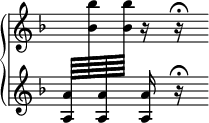of his art has carried him through the ordeal unscathed, from the first bar, where

becomes

down to the end, where Bach's
![{ \override Score.TimeSignature #'stencil = ##f \new StaffGroup \time 3/4 \partial 4 << \new Staff = "up" { \key d \minor \relative c'' << { c4 | cis8 s16. a32 cis8_\markup { \smaller etc. } } \\ \relative g' { r8 <g e c> | <a e> \change Staff = "down" a,32[ \change Staff = "up" cis e] } >> }
\new Staff = "down" { \clef bass \key d \minor \relative g { r8 g a s r } }
\new Staff = "pedal" { \clef bass \key d \minor \relative e { r8 e | g r r } } >> }](http://upload.wikimedia.org/score/4/l/4l4mobyeta9seejx1wqu1vaj1rtlkbr/4l4mobye.png)
becomes
![{ \override Score.TimeSignature #'stencil = ##f \new StaffGroup \time 3/4 \partial 8
<< \new Staff = "up" { \key d \minor \relative c'
{ <c e g c>8 | <cis e a cis> \times 8/10 { \change Staff = "down" \stemUp a,32([ cis e a
\change Staff = "up" \stemDown cis e g cis
\change Staff = "down" \stemUp \clef treble e a)] }
\change Staff = "up" r8_\markup { \smaller etc.; } } }
\new Staff = "down" \with { \consists "Span_arpeggio_engraver" } { \clef bass \set Staff.connectArpeggios = ##t \key d \minor
<< \relative c { <c e g>8\arpeggio | <cis e a> s4 cis'''4 } \\ \relative c, { <c c,>8\arpeggio | <g' g,>\arpeggio } >>
} >> }](http://upload.wikimedia.org/score/8/o/8ohtjntvrwkj17jquk42d9k8bsbykfs/8ohtjntv.png)
and the result in the hands of a competent performer is magnificent.
The point which this arrangement has in common with the foregoing classical examples, is its remarkable fidelity to the materials of the original, and the absence of irrelevant matter. The tendency of high class modern arrangements is towards freedom of interpretation; and the comparison of classical arrangements with their originals shows that this is legitimate, up to the point of imitating the idioms of one instrument by the idioms of another, the effects of one by the effects of another. Beyond that lies the danger of marring the balance of the original works by undue enlargement of the scale of particular parts, of obscuring the personality of the original composer, and of caricature, that pitfall of ill-regulated admiration, instances of which may be found in modern 'transcriptions,' which are the most extreme advance yet achieved in the direction of freedom of interpretation.
The foregoing is very far from exhausting the varieties of kinds of arrangement; for since these are almost as numerous as the possible interchanges between instruments and combinations of instruments, the only course open is to take typical instances from the best sources to illustrate general principles—and these will be found to apply to all arrangements which lay claim to artistic merit. To take for instance an arrangement of an orchestral work for wind band:—the absent strings will be represented by an increased number of clarinets of different calibres and corni di bassetto, and by the bassoons and increased power of brass. But these cannot answer the purpose fully, for the clarinets cannot take the higher passages of the violin parts, and they will not stand in an equally strong degree of contrast to the rest of the band. Consequently the flutes have to supplement the clarinets in places where they are deficient, and the parts originally belonging to them have to be proportionately modified; and in order to meet the requirements of an effect of contrast, the horns, trombones, etc. for lower parts, have to play a great deal more than in the original, both of melody and accompaniment. The part of the oboes will probably be more similar than any other, though it will need to be modified to retain its relative degree of prominence in the band. On the whole a very general interchange of the parts of the instruments becomes necessary, which is done with due respect to the peculiarities of the different instruments, both as regards passages and relative tone qualities, in such a manner as not to mar the relevancy and balance of parts of the whole work.
Of arrangements of pianoforte works for full orchestra, of which there are a few modern instances, it must be said that they are for the most part unsatisfactory, by reuson of the marked difference of quality between pianoforte and orchestral music. It is like trying to spread out a lyric or a ballad over sufficient space to make it look like an epic. Of this kind are the arrangements of Schumann's 'Bilder aus Osten' by Reinecke, and Raff's 'Abends' by himself. Arrangements of pianoforte accompaniments are more justifiable, and Gounod's 'Meditation' on Bach's Prelude in C, Liszt's scoring of the accompaniment to Schubert's hymn 'Die Allmacht,' and his development of an orchestral accompaniment to a Polonaise of Weber's out of the materials of the original, without marring the Weberish personality of the work, are both greatly to the enhancement of the value of the works for concert purposes. The question of the propriety of eking out one work with portions of another entirely independent one—as Liszt has done in the Introduction to his version of this Polonaise—belongs to what may be called the morale of arrangement, and need not be touched upon here. Nor can we notice such adaptations as that of Palestrina's 'Missa Papæ Marcelli'—originally written for 6 voices—for 8 and 4, or that by the late Vincent Novello of Wilbye's 3-part madrigals for 5, 6, and 7 voices.
As might be anticipated, there are instances of composers making very considerable alterations in their own works in preparing them for performance under other conditions than those for which they were originally written, such as the arrangement, so-called, by Beethoven himself of his early Octett for wind instruments in E♭ (op. 103) as a quintett for strings in the same
